重拾古代人体测量数据库:“美因茨打卡档案”和“日内瓦ADAM”,以及它们与更新和扩大的livescosta在线数据库的整合
IF 1.3
2区 哲学
0 PHILOSOPHY
引用次数: 1
摘要
研究项目LiVES(史前欧洲和西南亚的生活条件和生物标准)由德国研究基金会(DFG)的艾米-诺埃特项目资助,从2011年到2019年,除其他事项外,重点关注史前人类蛋白质摄入量与身高之间的关系,以此作为健康和饮食的可能代表。为了在项目的时间范围内获得与史前身高有关的足够数量的数据,然后可以将这些数据与有关的环境、时间和社会历史变量相关联,必须从两个现有的数据收集中获取和转换数据集:美因茨史前和历史人类学打孔卡档案和日内瓦人类学数据采集与管理(ADAM);它们最终被整合到一个新的、定期更新的在线数据库中,除了我们自己的目的之外,这个数据库还将供世界各地的学术机构和个人研究人员使用。经过检查和公布的数据来自6901个公元前600年的骨骼个体,以及总共18127个未经检查、未发表的骨骼条目,其中大部分可以追溯到后来的时期,它是目前欧洲和西南亚最大的史前和历史人类长骨和身材数据的数字收藏。在本文中,我们将详细报告在livess项目框架内的数据采集和集成过程,并描述其结构以及项目结束时的数据状态。此外,我们将对LiVES项目在LiVES- costa摘要集合中检查和更新的那些数据集的发布做一个非常简短的总结。本文章由计算机程序翻译,如有差异,请以英文原文为准。
Dusting off ancient anthropometric data banks: the “Mainz Punch Card Archive” and “Geneva ADAM” and their integration with the updated and enlarged LiVES-COstA online database
The research project LiVES (living conditions and biological standard of living in prehistoric Europe and South West Asia), funded by the Emmy-Noether-Programme of the German Research Foundation (DFG) and running from 2011 to 2019, focused - among other things - on the relationship between protein-intake and body height in prehistoric humans as a possible proxy for health and diet 1 . In order to obtain a sufficient amount of data relating to prehistoric body heights within the project’s timespan, which could then be correlated with relevant environmental, chronological and socio-historic variables, it was necessary to acquire and convert datasets from two already existing data collections: the Mainzer Lochkartenarchiv fur prahistorische und historische Anthropologie (Mainz punch card archive for prehistoric and historic anthropology) and the Geneva- based Anthropological Data Acquisition and Management (ADAM); they were eventually integrated with a new and regularly updated online database LiVES Collection of Osteological Anthropometry (LiVES-COstA) which, aside from our own purposes, is intended for future use by academic institutions and individual researchers around the world. With checked and published data from 6901 skeletal individuals dating up to 600 cal BCE, and a total of 18,127 unchecked, unpublished skeletal entries mostly dating to later periods, it is currently the largest digital collection of prehistoric and historic human long bone and stature data from Europe and Southwest Asia. In this article we will give a detailed report on the data acquisition and integration process within the framework of the LiVES-project, and describe the structure, as well as the state of data at the end of the project. Also, we will give a very brief summary on the publication of those datasets that have been checked and updated by the LiVES project in the LiVES-COstA Digest-collection.
求助全文
通过发布文献求助,成功后即可免费获取论文全文。
去求助
来源期刊

TOPOI-AN INTERNATIONAL REVIEW OF PHILOSOPHY
PHILOSOPHY-
CiteScore
3.10
自引率
7.10%
发文量
47
期刊介绍:
Topoi''s main assumption is that philosophy is a lively, provocative, delightful activity, which constantly challenges our received views, relentlessly questions our inherited habits, painstakingly elaborates on how things could be different, in other stories, in counterfactual situations, in alternative possible worlds. Whatever its ideology, whether with the intent of uncovering a truer structure of reality or of soothing our anxiety, of exposing myths or of following them through, the outcome of philosophical activity is always the destabilizing, unsettling generation of doubts, of objections, of criticisms. It follows that this activity is intrinsically a ''dialogue'', that philosophy is first and foremost philosophical discussion, that it requires bringing out conflicting points of view, paying careful, sympathetic attention to their structure, and using this dialectic to articulate one''s approach, to make it richer, more thoughtful, more open to variation and play. And it follows that the spirit which one brings to this activity must be one of tolerance, of always suspecting one''s own blindness and consequently looking with unbiased eye in every corner, without fearing to pass a (fallible) judgment on what is there but also without failing to show interest and respect. Topoi''s structure is a direct expression of this view. To maximize discussion, we devote most or all of this issue to a single topic. And, since discussion is only interesting when it is conducted seriously and responsibly, we usually request the collaboration of a guest-editor, an expert who will identify contributors and interact with them in a constructive way. Because we do not feel tied to any definite philosophical theme (or set of them), we choose the topic with absolute freedom, looking for what is blossoming and thriving, occasionally betting on what might - partly through our attention - ''begin'' to blossom and thrive. And because we do not want our structur e to become our own straightjacket, we are open to contributions not fitting the ''topos'', and do not rule out in principle the possibility of topic-less issues.
 求助内容:
求助内容: 应助结果提醒方式:
应助结果提醒方式:


